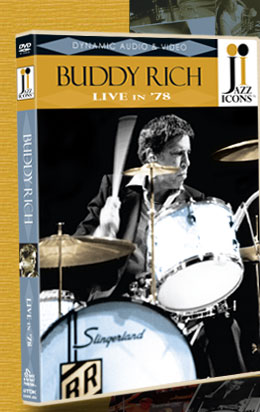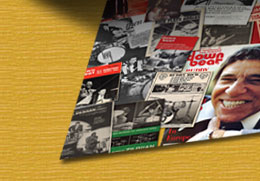




 |
 |
|
|||
|
|
|
||||
|
|
|
||||
|
|
|
||||
|
|
|
||||
 |
|
||||
 |
|
||||
 |
|
||||
|
|
|
|
|
|
|
 |
 |
 |
 |
Jazz Icons: Buddy Rich highlights the relentless power and unparalleled artistry of the man who was known as “The World’s Greatest Drummer.” This 75-minute concert, taped in Holland in 1978, showcases one of the tightest big bands in history, featuring acclaimed saxophonist Steve Marcus and other members of Buddy’s “Killer Force,” the group he would later call “the best band I ever had.” Standout performances include “Grand Concourse,” “Big Swing Face,” and “Channel One Suite,” which climaxes in Buddy’s signature drum solo. |
|
 |
|
Drums: Buddy Rich Alto Sax and Flute: Andy Fusco and Chuck Wilson Soprano Sax: Steve Marcus and Chuck Wilson Tenor Sax: Steve Marcus and Gary Pribeck Baritone Sax: Greg Smith Trumpet: John Marshall, Mike McGovern, Mark Ohlsen and Chuck Schmidt Trombone: Glenn Franke, Dale Kirkland, George Moran Piano: Bob Kaye Electric Bass: Tom Warrington |
Ya Gotta Try Little Train Best Coast Grand Concourse ‘Round Midnight Birdland Channel One Suite Big Swing Face |
20-page booklet Foreword by Buddy's daughter Cathy Rich Liner notes by Dean Pratt Cover photo by Tom Copi Booklet photos by Steve Peck, Tom Copi 1978 Down Beat interview with Buddy by his friend Mel Tormé Memorabilia collage Filmed in Holland Total time: 75 minutes |
|
|
Foreword:The question I am asked most is what was it like growing up with Buddy Rich as my father…it’s a hard question to answer… he was my dad… just like anyone else’s, except for what he did for a living. I have had an extraordinary life because of that and I wouldn’t trade it for anything. My father was many things… he was a multi dimensional character… he was hilariously funny, had the quickest wit of anyone I have ever known, he was emotional, tender, angry, and most of all a perfectionist and consummate artist. In essence, he was human. He was given a gift and used that gift to bring his music to everyone that he could. He spent his entire life making sure that the art form of jazz was never minimized or forgotten. ...
The concert you are about to watch is an example of just that. This band was one of my father’s favorites; you can tell that he loved playing with this young and talented group of musicians. He is happy and the band is on fire. This is a night captured on tape that will stand the test of time and still be amazing in another 20 or 50 years from now... true artistry never diminishes, it only grows as time goes on. Sit back, enjoy and be awed. Cathy Rich Excerpt from 1978 Down Beat interview: Sample Liner Notes by Dean Pratt: The band you see and hear on this DVD dates from July of 1978, and still has many of the musicians who joined the Killer Force during its transitional period, from May of 1977 until May of 1978. Steve Marcus, Buddy’s right-hand-man and featured soloist, was there from the Killer Force’s beginnings and would remain with Buddy until the drummer’s untimely passing in 1987. Saxophonists Chuck Wilson, Andy Fusco, Gary Pribeck and Greg Smith; lead trombonist Dale Kirkland; lead trumpet Chuck Schmidt; trumpeter John Marshall and bass player Tom Warrington may all be considered members of the Killer Force. Buddy’s playing and affect here at North Sea is just as I remember it during my marvelous two years on the stand with him. He is happy, strong, fit, and, as you now have the pleasure of seeing and hearing, the greatest drummer ever to propel a big band. When I was with him, I left the stand every night in awe of the genius of Buddy Rich and now, thanks to this DVD, everyone can catch a rare glimpse of what those nights were all about. On July 3, 1978, Buddy and the band appeared as part of George Wein’s Newport Jazz Festival, which by then had moved to Saratoga, New York. Wein was responsible for booking the band for one of his European versions of the Jazz Festival, commencing on July 12 and 13 in Nice, France, where Buddy’s mentor, Jo Jones, sat in with the band along with Stan Getz and Lionel Hampton. It was a whirlwind tour with the North Sea Jazz Festival on the 14th, followed by the Montreux Jazz Festival and concerts in Sweden and England. ... What a concert it was. The band opens, as Buddy did on many occasions, with Sammy Nestico’s composition, “Ya Gotta Try,” a staple in the Killer Force library. Both Buddy and Basie recorded this number on their 1977 GRAMMY®-nominated albums. On the recording, Buddy’s band roars through this Nestico chart with blistering tenor solos from Steve Marcus and Bob Mintzer, and it exemplifies just what this band was all about—taking no prisoners. Here at North Sea was no exception. Bob Kaye on piano is up first and then Steve Marcus and Gary Pribeck handle the tenor sax exchanges. It’s a typical barnstorming Buddy Rich opener, which lets the audience know they are about to hear big band swing at its best. Dale Kirkland: “I joined the band in early 1977, replacing Clint Sharmon in the jazz chair on second trombone. Rick Stepton, who had got me the gig with Woody Herman, had just left and, as you know, we went through a couple of lead trombone players before I finally convinced Buddy to let me play the lead book. He liked my jazz and was reluctant to move me over and, in fact, when I finally did move over he made me continue playing most of the jazz and the lead. Of course, I had to put an end to that and told him it was too much for me. Besides, Glenn Franke was such an excellent soloist.” John La Barbera was the chief arranger for the band in the early ’70s, and his composition, “Best Coast,” made its debut on Buddy’s third album for RCA entitled Stick It, recorded in 1972. John’s brother Pat took the original soprano sax solo on the album, but this solo, like so many others after he joined the band in 1975, became identified with the extraordinary musicianship of Steve Marcus. Tragically, Steve passed away in 2005 and the jazz community lost one of its most original voices. Bob Kaye’s piano weaves in and out of this pretty waltz, with Glenn Franke’s trombone spot following Marcus’s soprano. Buddy would keep this La Barbera chart in the book until the band played its last gig on December 10, 1986. All words and artwork on this page ©Reelin' In The Years Productions. Unauthorized use is prohibited.
|
|
Site contents ©Copyright 2006 Reelin' In The Years Productions
Site designed by Tom Gulotta